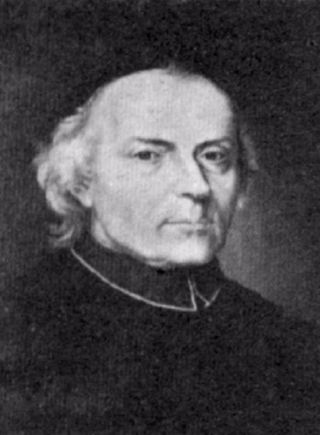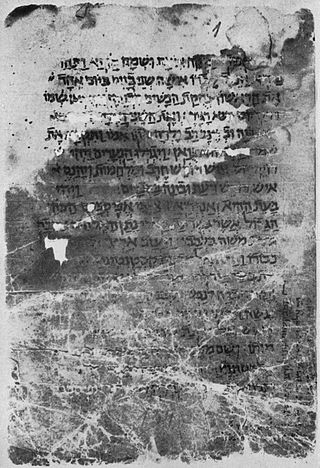
Lodovico Antonio Muratori was an Italian Catholic priest, notable as historian and a leading scholar of his age, and for his discovery of the Muratorian fragment, the earliest known list of New Testament books.

Lupus Protospatharius Barensis was the reputed author of the Chronicon rerum in regno Neapolitano gestarum, a concise history of the Mezzogiorno from 805 to 1102. He has only been named as the author since the seventeenth century. Lupus, along with two other Bariot chronicles, the Annales barenses and the Anonymi Barensis Chronicon, used some lost ancient annals of Bari up to 1051. William of Apulia appears to have used these same annals. Lupus also used the lost annals of Matera. Perhaps most unusual to Lupus is his dating method. He began his years in September and so places events of the latter half of a given year in the next year.
Richard of San Germano was a notary in San Germano in the Latin Valley not far from the monastery of Monte Cassino between February 1186 and March 1232. He wrote a chronicle of the Mezzogiorno from the death of William II of Sicily in 1189 to 1243. It is the fullest source of information on the Hohenstaufen in Italy.
Marules was the Byzantine catepan of Italy in 1060/1061. Appointed by the Emperor Constantine X, he arrived in Bari between 1 September 1060 and 31 August 1061, according to the Anonymous Chronicle of Bari. He was the first catepan appointed after Argyros left Italy in 1058. He had been preceded in 1060 by a merarches, but the latter's offensive against the Normans had peaked before his arrival and he adopted a defensive posture.
Sirianus was the Byzantine catapan of Italy, the second appointed by the Emperor Constantine X Doukas. He arrived in Bari, the seat of the catapanate, in 1061 or 1062, replacing Marules, who had been appointed the previous year. Constantine was the last emperor who took an interest in recovering ground in Italy, but Sirianus was on the defensive against the Norman state and recovered no territory. According to the annals of Lupus Protospatharius, the Norman duke Robert Guiscard captured Oria and Brindisi in the year of his appointment and Taranto in the following year. He was succeeded in 1064 by Abulchares.
The Chronicon Ambrosianum or Chronica parva Ambrosianum is a set of exceedingly terse medieval Latin annals that, together with the Annales Compostellani and the Chronicon Burgense, forms a group of related histories. These were collectively labelled the Efemérides riojanas by Manuel Gómez-Moreno, who thought they had been compiled in La Rioja. The Chronicon is named after the Biblioteca Ambrosiana in Milan, where its manuscript was discovered. It was first published by Ludovico Antonio Muratori.
The Breve chronicon Northmannicum or Little Norman Chronicle is a short, anonymous Latin chronicle of the Norman conquest of southern Italy, probably written in Apulia in the early twelfth-century. It covers the years from the first Norman "invasion" of Apulia in 1041 to the death of Robert Guiscard in 1085. Though once treated as an important source, its reliability and authenticity have been called into question by André Jacob, who showed that it is probably an eighteenth-century forgery by Pietro Polidori. According to John France, who seems unaware of Jacob's argument, it was based mainly on an oral tradition and was subsequently used as a source for both the Chronicon Amalfitanum and Romuald Guarna.
Troisi is a surname of Italian origin. The name originates from the Latin Trogisii which refers to descendants of Trogisio or others of the same name. It may refer to:
The Annales Cavenses are a chronicle compiled at the La Trinità della Cava abbey in Cava de' Tirreni, province of Salerno, southern Italy. It consists of annalistic entries spanning the years 568 to 1318, i.e. essentially the entire duration of the Middle Ages in Italy.
Lorenzo de Monacis was a diplomat serving the Republic of Venice. He was also an influential historian whose chronicles were relied upon by Flavio Biondo and Marcantonio Sabellico.

Andreas was the Archbishop of Bari from 1062 to at least 1066, and probably somewhat longer. In 1066, he travelled to Constantinople where at some point he converted to Judaism. He then fled to the Muslim-dominated Egypt and remained there until his death in 1078.
The Annales Barenses is an anonymous set of annals written in the city of Bari in the late eleventh century. At the time of its composition, Bari was the chief city of the Byzantine Empire in southern Italy.
Bisantius Guirdeliku was a noble citizen of Bari, then the capital of the Byzantine catepanate of Italy. He held the rank of patrikios. During the siege of Bari (1068–71) by the Normans, he led the faction opposed to surrender until he was assassinated by his rival, Argirizzo, in 1070. His nickname is known from the anonymous Annales Barenses and the chronicle of Lupus Protospatharius.
The Anonymi Chronicon Austriacum is an anonymous Middle Latin chronicle that covers the years 973–1327. It was first published in 1793 by Adrian Rauch alongside the Annales Zwetlenses, both from a paper manuscript he found in the Bibliotheca Palatina Vindobonensis.
Nicolò Miglani was a Venetian diplomat and colonial official in the 1260s and 1270s.
Roscemanno, O.S.B.Cas. was a Roman Catholic Cardinal and Deacon of San Giorgio in Velabro.
Rerum italicarum scriptores ab anno æræ christianæ quingentesimo ad millesimumquingentesimum is a collection of texts which are sources for Italian history from the 6th to the 15th century, compiled in the 18th century by Ludovico Antonio Muratori.
Felice Osio, was an Italian cleric, scholar, and writer.
Orazio Filippo Bianchi was an Italian lawyer and classical scholar.



